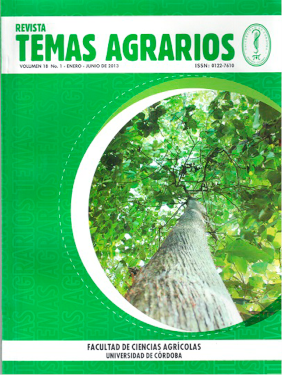Evaluation of bioproducts fitomas E and dimabac in the tomato crop
Evaluación de los bioproductos dimabac y fitomas E en el cultivo del tomate

This work is licensed under a Creative Commons Attribution-NonCommercial 4.0 International License.
Show authors biography
The objective of this study was to evaluate the effect of bioproducts DIMABAC and FitoMas E on the cultivation of tomato in Red Ferralitic soil conditions. The research was conducted at the ¨Liliana Dimitrova ¨ Horticultural Research Institute (IIHLD), Cuba, during two seasons (2009 – 2010 and 2010 – 2011). Seven treatments, including the combination of DIMABAC and FitoMas E with two levels of nitrogen fertilization, were distributed with a randomized block design with three replicates, vegetative growth, morphological and production were evaluated. DIMABAC and biostimulant FitoMas E plus 70% of nitrogen fertilizer induced the highest values of vegetative growth, morphology and production, N supply was reduced by 30% thereby constituting an alternative for the mineral nutrition management of tomato cultivation
Article visits 739 | PDF visits
Downloads
- Arteaga, M., Garcés, N., Guridi, F., Pino, J., Caro, I., Bernardo, O., Calzadilla, J., Mesa, S., LÛpez, A., Ruis•nchez, Y., MenÈndez, J. y Cartaza, O. 2006. Respuestas del tomate Amalia a las aplicaciones de humus líquido en condiciones de producción. Cultivos tropicales 32:7-12.
- Bach, A. T. y DÌaz, M. 2008. Las Rizobacterias Promotoras del Crecimiento Vegetal (PGPR) en la agricultura. Agricultura Orgánica 3:35-38.
- Bertsch, F. 1995. La Fertilidad de los suelos y su manejo. Asociación Costarricense de la ciencia del suelo, Costa Rica, p12-13.
- Brito, A., Dibut, B., Arozarena, N., RÌos, Y., Croche, G., Fernandez, J., Ramos, H., Creagh, B. y Ortega, M. 2008. Influencia del bioestimulante FitoMas E sobre la concentración y efecto de microorganismos rizosféricos de interés agrícola. www.actaf.co.cu/revistas/ agrotecnia_05_2008/agrot2006-1/5.pdf [23 Julio 2009].
- CUBA. MINISTERIO DE LA AGRICULTURA. 1987. Norma ramal MINAG837–87: análisis químico de suelos: reglas generales. Ciudad de la Habana: Agrinfor, 26p.
- Faustino, E. 2006. Contribución del FitoMas E a la sostenibilidad de la finca Asunción de la CCS “Nelson Fernández”. Tesis de ingeniero agrónomo, UNAH, La Habana, Cuba.
- Hernández, A., Ascanio, M. O. y Morales, M. 2006. Correlación de la nueva versión de Clasificación genética de los suelos de Cuba con las clasificaciones internacionales y Nacionales. Memorias VI Congreso de la Sociedad Cubana de la Ciencia del suelo, La Habana, Cuba, marzo 2006, p8-10.
- IIHLD. 1997. Memorias 25 Aniversario. La Habana, Cuba, p98.
- López, A. 2008. Medidas para el desarrollo de la agricultura en Cuba. Ciudad de La Habana: MINAG, p52.
- López, R., Montano, R., Lobaina, J., Montoya, A. y Coll, O. 2006. Comportamiento de plantas hortícolas con diferentes dosis de Fitomas E en condiciones edafoclimaticas de Guantánamo. Memorias XV Congreso científico INCA, La Habana, Cuba, p12-14.
- Martínez, V.R., López, M., Dibut, A., Parra, Z. y Rodríguez, J. 2007. La fijación biológica del nitrógeno atmosférico en condiciones tropicales. MAT, Caracas Venezuela, p172.
- MINAG. 2009. Instructivo técnico del cultivo del tomate. CIDA, La Habana, Cuba, p21.
- Montano, R. 2008. FitoMas E, bionutriente derivado de la industria azucarera: Composición, mecanismo de acción y evidencia experimental (ICIDCA). www. icidca.cu/Productos/FitoMas%20E.%20 Principales%20resultados.doc [23 Mayo 2010].
- Morales, M. 2011. Los biofertilizantes. Una alternativa productiva, económica y sustentable. www.pa.gob.mx/publica/ rev_36/Marcel%20Morales%20Ibarra. pdf [23 Julio 2011].
- ONE. 2012. Cuba en cifras. En: (CD-ROM). Oficinas Nacional Estadística. Ciudad de la Habana.
- Pérez, C. R. 2005. Efecto de diferentes dosis del biofertilizante Micorriza y el control biológico DIMABAC compuesto por Azotobacter chroococcum y Bacillus subtilis en el cultivo del ají chay en áreas del Instituto Politécnico Agropecuario Villena-Revolución. Tesis de Licenciado Agropecuario. C. Habana, Cuba.
- Rodríguez, S. J.; Tejeda, G. G.; Izquierdo, D. L.; García, G. R.; García, H. A.; Socas, E. U.; Martínez, M. A.; Dibut, A. B.; Martínez, V. R.; Ríos, R. Y.; Ortega, G. M.; Fey, G. L.; Mesa, V. E.; Cañizares, H. K y Simanca, M. M.E. 2008. Aplicación del DIMABAC en zanahoria (Daucus carota L.): biofertilización y protección contra enfermedades en organoponía. En: Congreso INCA, La Habana, Cuba.
- Rodríguez, P. 2005. Influencia de la biofertilización en el cultivo del tomate (lycopersicon esculentum, Mill). http://www.santiago.cu/cienciapc/numeros/2005/3/articulo03.htm [19 Octubre 2010].
- USA, SGC (Statistical Graphics Corporation). 2000. Statgraphics Plus for Windows: Version 5.0.




















